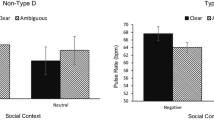Abstract
The present study investigated the relationship between the Type A Coronary-Prone Behavior Pattern and two measures of self-relevant cognitions: Ellis's (1962) irrational beliefs, and private and public self-consciousness (Fenigstein, Scheier, & Buss, 1975). The Type A pattern was found consistently to be negatively correlated with a belief in the value of avoiding problems and responsibilities. For males, the Type A pattern was also correlated with irrational beliefs about self-standards for achievement and perfectionism. For females, the Type A pattern was correlated with private self-consciousness and beliefs involving overreaction to frustration and anxious overconcern about potential problems. The results are discussed in terms of the relationship of these cognitive variables to the behavioral components of the Type A pattern and the implications of such relationships for potential cognitive interventions.
Similar content being viewed by others
References
Burnam, M., Pennebaker, J., & Glass, D. Time consciousness, achievement striving, and the Type A coronary-prone behavior pattern.Journal of Abnormal Psychology 1975,84 76–79.
Carver, C., Coleman, A., & Glass, D. The coronary-prone behavior pattern and the suppression of fatigue on a treadmill test.Journal of Personality and Social Psychology 1976,33 460–466.
Carver, C., & Glass, D. Coronary-prone behavior pattern and interpersonal aggression.Journal of Personality and Social Psychology 1978,36 361–366.
Dembroski, T., MacDougall, J., & Shields, J. Physiologic reactions to social challenge in persons evidencing the Type A coronary-prone behavior pattern.Journal of Human Stress 1977,3 2–10.
Dembroski, T. M., Weiss, S. M., Shields, J. M., Haynes, S. G., & Feinleib, M. (Eds.),Coronary-prone behavior. New York: Springer-Verlag, 1978.
Ellis, A.Reason and emotion in psychotherapy. New York: Lyle Stuart Press, 1962.
Fenigstein, A., Scheier, M., & Buss, A. Public and private self-consciousness: Assessment and theory.Journal of Consulting and Clinical Psychology 1975,43 522–527.
Friedman, M., & Rosenman, R. Association of specific overt behavior pattern with blood and cardiovascular findings: Blood clotting time, incidence of arcus senilis, and clinical coronary artery disease.Journal of the American Medical Association 1959,169 286.
Glass, D.Behavior patterns, stress, and coronary disease. Hillsdale, New Jersey: Elbaum, 1977.
Jenkins, C. D. Recent evidence supporting psychologic and social risk factors for coronary disease.New England Journal of Medicine 1976,294 987–994; 1033–1037.
Jenni, M., & Wollersheim, J. Cognitive therapy, stress management training, and the Type A behavior pattern.Cognitive Therapy and Research 1979,3 61–73.
Jones, R.The Irrational Beliefs Test. Wichita: Test Systems, 1969.
Kendall, P., & Korgeski, G. Assessment and cognitive-behavioral interventions.Cognitive Therapy and Research 1979,3 1–21.
Lohr, J., & Bonge, D.The relationship of coronary-prone behavior and irrational beliefs in college-age and middle-age males. Paper presented at the first annual meeting of the Society for Behavioral Medicine, San Francisco, 1979.
MacDougall, J., Dembroski, T., & Musante, L. The structural interview and questionnaire methods of assessing coronary prone behavior in male and female college students.Journal of Behavioral Medicine 1979,2(1), 71–83.
Meichenbaum, D. Cognitive modification of test anxious college students.Journal of Consulting and Clinical Psychology 1972,39 370–380.
Novaco, R. Treatgment of chronic anger through cognitive and relaxation controls.Journal of Consulting and Clinical Psychology 1976,44 681.
Pittner, M., & Houston, B. K. Response to stress, cognitive coping strategies, and the Type A behavior pattern.Journal of Personality and Social Psychology 1980,39 147–157.
Shorkey, C., & Whiteman, V. Development of the Rational Behavior Inventory: Initial validity and reliability.Educational and Psychological Measurement 1977,37 527–534.
Suinn, R. & Bloom, L. Anxiety management training for Pattern A behavior.Journal of Behavioral Medicine 1978,1 25–35.
Sutton-Simon, K. Assessing belief systems: Concepts and strategies. In P. C. Kendall & S. D. Hollon (Eds.),Assessment strategies for cognitive-behavioral interventions. New York: Academic Press, 1981.
Thurstone, L.Thurstone temperament schedule. Chicago: Science Research Associates, 1953.
Van Egeren, L. F. Social interactions, communications, and the coronary-prone behavior pattern: A psychophysiological study.Psychosomatic Medicine 1979,41 2–18.
Weidner, G., & Matthews, K. Reported physical symptoms elicited by unpredictable events and the Type A coronary-prone behavior pattern.Journal of Personality and Social Psychology 1978,36 1213–1220.
Author information
Authors and Affiliations
Additional information
The authors wish to thank Allison Baker and Jim Pendleton for their help in conducting the study.
Rights and permissions
About this article
Cite this article
Smith, T.W., Brehm, S.S. Cognitive correlates of the Type A Coronary-Prone Behavior Pattern. Motivation and Emotion 5, 215–223 (1981). https://doi.org/10.1007/BF00993885
Issue Date:
DOI: https://doi.org/10.1007/BF00993885




